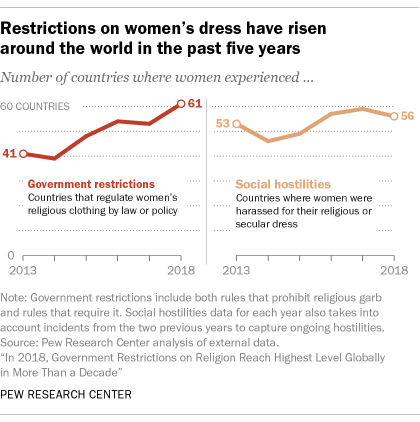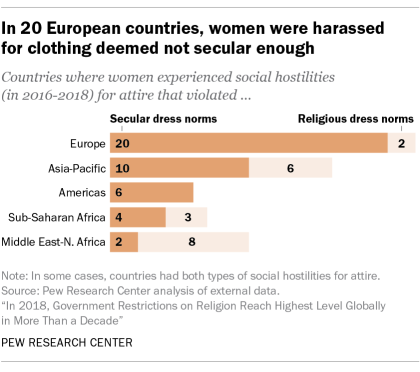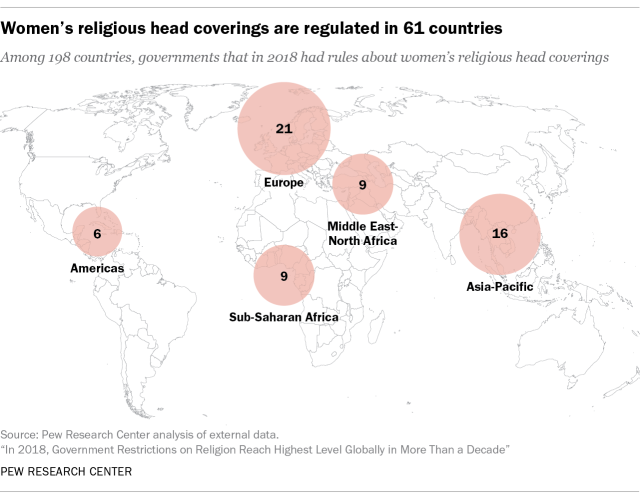
Religious restrictions around the world often target women, who in many countries face censure because their clothing is considered too religious – or not religious enough. These restrictions frequently take the form of social harassment by individuals or groups, but also sometimes involve official government actions.
Women in 56 countries experienced social hostilities – that is, harassment from individuals or groups – due to clothing that was deemed to violate religious or secular dress norms, according to the sources analyzed for a recent Pew Research Center study of 198 nations. Social harassment can range from verbal abuse to physical violence or killings motivated at least in part by the target’s religious identity; incidents for this measure took place between 2016 and 2018.
Meanwhile, women in 61 countries faced government restrictions on dress – specifically, regulations on their head coverings. This measure covers rules that were in place or incidents that occurred in 2018.
The number of countries where women faced social hostilities and government-imposed restrictions related to their dress has risen in the five most recent years of the study.
Pew Research Center measures government regulations and social hostilities tied to religious symbols and women’s clothing as part of an annual series that analyzes the extent to which governments and societies around the world impinge on religious beliefs and practices. The most recent report in this series, the Center’s 11th annual, is part of the Pew-Templeton Global Religious Futures project, which analyzes religious change and its impact on societies around the world.
To measure global restrictions on religion in 2018 – the most recent year for which data is available – the study rates 198 countries and territories by their levels of government restrictions on religion and social hostilities involving religion. The new study is based on the same 10-point indexes used in the previous studies.
- The Government Restrictions Index measures government laws, policies and actions that restrict religious beliefs and practices. The GRI comprises 20 measures of restrictions, including efforts by government to ban particular faiths, prohibit conversion, limit preaching or give preferential treatment to one or more religious groups.
- The Social Hostilities Index measures acts of religious hostility by private individuals, organizations or groups in society. This includes religion-related armed conflict or terrorism, mob or sectarian violence, harassment over attire for religious reasons, or other religion-related intimidation or abuse. The SHI includes 13 measures of social hostilities.
To track these indicators of government restrictions and social hostilities, researchers combed through more than a dozen publicly available, widely cited sources of information, including the U.S. State Department’s annual reports on international religious freedom and annual reports from the U.S. Commission on International Religious Freedom, as well as reports from a variety of European and UN bodies and several independent, nongovernmental organizations. (See Methodology for more details on sources used in the study.)
Social hostilities
In 42 of the 56 countries where sources indicated that social harassment took place between 2016 and 2018, women were targeted for violating secular dress norms, such as by wearing a hijab or other religious garb. In 19 countries, women were harassed for not adhering to religious dress codes, such as by not wearing head coverings or dressing in other ways deemed offensive to religious norms. (In five countries in the study — Germany, India, Indonesia, Israel and Russia — women experienced both types of harassment.)
In four of the five regions covered in the study, social harassment for overly religious clothing was more common than harassment for overly secular clothing. The exception was the Middle East and North Africa, where women more commonly faced harassment for clothing deemed too secular.
Europe had the most countries where women faced social hostilities for violating dress norms, with incidents recorded in 20 countries, or 44% of the 45 nations in the region. In all of these cases, Muslim women faced discrimination, physical violence and other forms of abuse for wearing head coverings. In Denmark, for example, a driver refused to cede a parking space to a Muslim woman in 2018 because she was wearing a headscarf. And in Germany, a woman hit a Muslim woman and tried to remove her headscarf.
The Asia-Pacific region had the second-most countries with such incidents, with women facing harassment for violating dress codes in 14 of the region’s 50 nations, or 28%. In 10 of these countries, women were harassed for clothing that was deemed too religious, whereas in six countries, they experienced harassment for attire that was considered too secular (in two countries – India and Indonesia – both types of harassment occurred). In Malaysia, for instance, police in 2018 arrested a man who admitted to assaulting a woman because she was not wearing a headscarf. And in Kyrgyzstan in 2016, billboards sparked debate over religious dress in the country by displaying photos of women in various forms of Islamic dress with the caption “Oh, poor nation, where are we headed?” The displays were seen as a commentary on the spread of foreign and overly religious dress customs in the country.
Women faced social hostilities for violating dress codes in seven countries in sub-Saharan Africa and six countries in the Americas. In sub-Saharan Africa, women were harassed for violating secular dress codes in four countries, and for violating religious dress codes in three. In parts of Kenya, for example, a teacher’s union reported in 2018 that female teachers were required to wear hijabs, while in Liberia, Muslim women reportedly experienced workplace discrimination for wearing headscarves.
In the Americas, all instances of harassment targeted women who wore clothing considered too religious. In Trinidad and Tobago, for example, a Muslim teacher at a Hindu school in 2018 was told to remove her hijab or leave the premises. And in Canada in 2016, a woman spit on and pulled the hijab and hair of a Muslim shopper in a supermarket in Ontario.
In the Middle East and North Africa, eight of 20 countries saw harassment for overly secular attire, while two countries saw it for overly religious clothing. In Israel, for instance, a group of Orthodox Jewish men in 2018 were seen chasing and yelling at a girl for dressing that they perceived as “immodest.” In Qatar, a Muslim woman in 2016 was criticized for appearing on a news program without a hijab.
Government restrictions
Official rules about the wearing of religious symbols – such as hijabs for women and beards for men – are another form of religious restriction observed around the world. In the vast majority of countries where such restrictions were recorded in 2018, they targeted head coverings for women.
Every region had at least some rules about women’s headdress. Europe had the most countries where women’s head coverings were restricted by the government, with instances in 21 of 45 countries. In Norway, for example, the government passed a ban on face-covering clothing at educational institutions, preventing students and teachers from wearing niqabs and burqas in schools and daycare centers. The country continued to ban religious headwear and other religious symbols from being worn with police uniforms, but allowed religious headwear in the military.
Governments regulated women’s headdress in 16 countries in the Asia-Pacific region, nine in the Middle East and North Africa, nine in sub-Saharan Africa and six in the Americas. In Australia, for instance, a judge did not allow a woman to wear a niqab in the court’s public spectator gallery during her husband’s trial on charges of terrorism. In Turkey, by contrast, students and parents claimed a school principal in the city of Urfa threatened that female students would receive failing grades if they did not wear head coverings.
In some countries, governments have specific rules for the type of religious clothing women should wear. In Iran, for example, the government requires all women to adhere to “Islamic dress” standards in public, including covering their hair and bodies in loose clothing.





